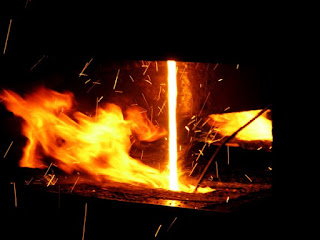A blog providing information about industrial temperature measurement, specifically in the areas of temperature sensors. The posts will contain educational information about thermocouples, RTDs, and other common types of temperature sensors. The application of these sensors will focus on aerospace, aircraft, research and development, medical, chemical, plastics processing, and power generation industries. For more, visit Duro-Sense.com or call 310-533-6877.
Wednesday, April 24, 2019
Friday, April 19, 2019
Thermocouples: Proper Use, Recommended Practices, and Avoiding Problems
 |
Proper use and maintenance of thermocouple systems begin with good system design based on the strengths and weaknesses of various thermocouple types. Because these sensors contain sensitive electronics, general good practice includes use of shielded cases and twisted- pair wire, use of proper sheathing, avoidance of steep temperature gradients, use of large-gauge extension wire, and use of guarded integrating voltmeters or ohmmeters, which electronically filter out unwanted signals. The signal conditioner should be located as close as possible to the sensor, and twisted copper-wire pairs should be used to transmit the signal to the control station. To minimize electromagnetic field interference, sensor system wires should not be located parallel to power supply cables. The primary causes of loss of calibration in thermocouples include the following:
- Electric “noise” from nearby motors, electric furnaces, or other such electrically noisy equipment;
- Radio frequency interference from the use of hand-held radios near the instrument.
- “Ground loops” that result when condensation and corrosion ground the thermocouple and create a ground loop circuit with another ground connection in the sensing circuit.
Most problems with thermocouples are aggravated by use of the thermocouple to measure temperatures that approach or exceed their upper temperature limits. Careful recording of events that could affect measurements should be kept in a logbook. Any adjustments or calibrations should also be recorded. The logbook should contain the names of individuals performing maintenance and calibrations as well as defined procedures. In systems monitoring many locations, such a log is especially useful for fault diagnosis.
Thermocouples sometimes experience catastrophic failures, which may be preceded by extreme oscillations or erratic readings. In such cases, all connections associated with the thermocouple should be checked for loose screws, oxidation, and galvanic corrosion. In many cases, drift may be a more serious problem because it can go unnoticed for long periods of time. The most common causes of loss of calibration are excessive heat, work hardening, and contamination. Work hardening generally is due to excessive bending or vibration and can be prevented with properly designed thermowells, insertion lengths, and materials. Contamination is caused by chemicals and moisture, which sometimes attack wiring by penetrating sheaths, and can result in short-circuiting. A simple test to check for this problem is to disconnect the sensor at its closest connection and check for electrical continuity between the wires and the sheath using a multimeter. If the meter indicates continuity, the sensor should be replaced. Because the electromotive force (EMF) produced by thermocouples is so small, electrical noise can severely affect thermocouple performance. For that reason, it also is very important that transmitters be isolated. Thermocouples used in the vicinity of electrostatic precipitators must be shielded to avoid electrical interference. If the potential electrical interference is high, an RTD or other type of sensor may be preferred to thermocouples. With respect to thermocouple and protection tube selection, the following should be noted:
- Type J thermocouples particularly should not be used in applications in which they might be exposed to moisture because the iron in the thermocouple will rust and deteriorate quickly;
- Type K thermocouples should not be used in the presence of sulfur, which causes the element to corrode; because cutting oils often contain sulfur, protection tubes should be degreased before being used; stainless steel sheaths should be used to protect Type K thermocouples in stacks where SO2 emissions are significant;
- Platinum thermocouple elements (Types R, S, or B) should not be used with metal protection tubes unless the tubes have a ceramic lining because the metal will contaminate the platinum;
- Ceramic, silicon carbide, and composite (metal ceramic, Cerite-II, Cerite-III) protection tubes are subject to thermal shock and should be preheated prior to inserting in high temperature process environments; and
- Molybdenum - or tantalum-sheathed thermocouples will fail rapidly if placed in oxidizing atmospheres.
During one study of thermocouple performance, 24 combinations of thermocouple and sheath material types were tested at temperatures up to 1200 C (2200 F). The results indicated that above 600 C (1110 F) thermocouples are affected by complex chemical interactions between their components; even though wires and sheaths were physically separated, exchange of constituents occurred. The study concluded that thermocouples maintain calibration better if sheath material is similar in composition to thermocouple alloys. By using similar alloys longer performance can be expected for sensors subjected to temperatures above 600 C (1110 F), and the use of similar alloys is essential for temperatures above 1000 C (1830 F).
For more information on the proper use of thermocouples, contact Duro-Sense Corporation by calling (310) 533-6877 or visit their website at https://duro-sense.com.
Reprinted from CAM Technical Guidance Document courtesy of EPA.gov.
Subscribe to:
Posts (Atom)
